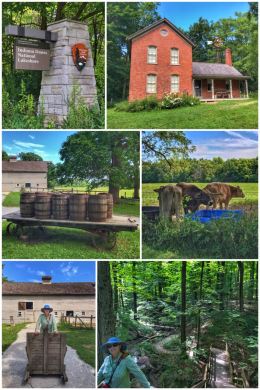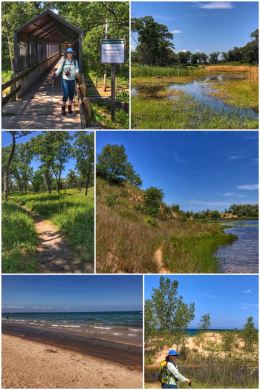
After a bit of a national park hiatus, we were extremely happy to arrive in northern Indiana so that we could visit our 39th national park on this great adventure: Indiana Dunes National Park, located along the shore of Lake Michigan, and the first and only national park in Indiana. (This visit marked the third state in which we have seen and experienced Lake Michigan, one of the Great Lakes.)
We started our exploration at the visitor center, located on North Indiana State Road 49 in Porter — about 44 miles west of South Bend (where we were staying) and about 50 miles southeast of Chicago. We chatted with a ranger about possible hikes, picked up a few brochures on the trails we were most interested in hiking, bought a magnet (which still says National Lakeshore) and watched the park’s video (which definitely needs some upgrading to HD). The visitor center also has restrooms and an activity center.
The 15,000-acre park started its life in 1966 as the Indiana Dunes National Lakeshore. It became the nation’s newest and 61st national park earlier this year on February 15 — which just happens to be our wedding anniversary! How cool is that?
The park runs along 25 miles of Lake Michigan shoreline and protects sand dune, wetland, prairie, river, and forest ecosystems, as well as several historic structures. Indiana Dunes State Park, which protects about 2,182 acres and has 3 miles of beach along Lake Michigan, is adjacent to the national park. While we did not go to the state park, it should be noted that it has 7 trails ranging from easy to rugged — and promotes the 3 Dune Challenge (Trail #8) in which you climb the three tallest sand dunes in the park… Mt. Tom (192-feet), Mt. Holden (184-feet), and Mt. Jackson (176-feet).

We decided to start our exploration of the national park at the Chellberg Farmhouse, the preserved home of a hardworking, Swedish immigrant family who lived and worked here for three generations, starting in 1869 when Anders and Johanna bought 40 acres of farmland. As soon as we heard Swedish (which is Jen’s heritage), we were hooked. It was a working farm until 1972, when the family sold it to the National Park Service.
Besides the restored brick farmhouse (shown in the picture, and only open during ranger-led tours), the park service manages chickens, turkeys, goats, and cows on the old farm.
Also in the same area is the Bailly Homestead, a National Historic Landmark. It was the home of Honore Gratien Joseph Bailly de Messein (1774 – 1835), who played a role in the development of the Calumet Region of northern Indiana.
This area of the park also offers several intersecting trails to hike, including the Little Calumet River Trail, which can add up to a few miles of hiking.

We next traveled westward about 10 miles to just outside Gary, Indiana, to hike the one trail that our ranger gushed so much about we just had to do it… the Paul H. Douglas Trail, a 3.2-mile (RT) trail that winds through Miller Woods, a rare black oak savanna before heading through the dunes and eventually ending at Lake Michigan.
The trail takes hikers through the ridges and swales of this unique area… landforms that are about 3,000 years old, with an oak savanna ecosystem located along the ridges and wetlands found in the swales. Almost 300 species of plants can be found here, including black oak, marram grass, mountain honeysuckle, inland june-berry, pasture rose, red oak, cottonwood, lupine, goldenrod, and yellow and white pond lily.
The rare savanna only survives when fire periodically spreads through the underbrush… and happily, the Park Service now attempts to mimic nature by setting occasional prescribed burns.
The hike itself is harder than the length suggests because some of the surface, especially along the dunes, is soft sand, and you are hiking up the ridges and down into the swales. We loved the butterflies and many frogs we saw along the trail, but the most fascinating part of the hike is that you spend much of it in the beautiful isolation of nature… until you get ever closer to Lake Michigan (and hear sounds of boats and sea-doos). And once you make that final climb up the dune and over onto the shores of the lake, you are overwhelmed with humanity… whether it is simply the skyline of Chicago in the distance or a massive number of people enjoying the beach — as we experienced that day… because just east of the trail lies Lake Street Beach — and people were out in full force enjoying themselves.
Other areas to explore at the national park include the West Beach — which offers beach and swimming, of course, but also several trails (ranging from under a mile to 3+ miles) through dunes and along Long Lake. Cowles Bog is another fascinating area of the park — and one with the rugged 5-mile Cowles Bog Trail through wetlands and over wooded dunes. Pinhook Bog is another cool area, but only open for ranger-led walks. Finally, there is Mt. Baldy, the park’s most dynamic sand dune, standing at 126 feet tall. (We thought about tackling this hike, but after the tough hike through Miller Woods, we decided we were done!)
While at the park, you can learn about the formation of Lake Michigan, which started to take form 11,000 years ago as the mile-thick Wisconsin glacier — the last one in this region — began to melt… leaving behind Lake Michigan and the other four Great Lakes.
For those who want to camp in the national park, it does have one campground: Duneland, located near Beverly Shores.
Next up for us is an adventure through Ohio… and another national park: Cuyahoga Valley National Park!

One comment